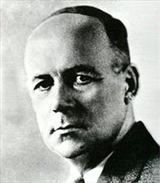by Johnathan Storlie, PhD
Why we named ourselves Giants of the Earth: Rolvaag’s Influence
 We, who formed Giants of the Earth Heritage Center, have all come under the influence of the great author Ole Rølvaag. Rølvaag beautifully described the early pioneers’ trials and tribulations. In ancient Norse and Northern European literature, the term “Giants” was used to describe various forces of nature. Many of the settlers, in contending with these forces, became stronger and more resolute in their determination to build a home and leave a legacy for their descendants. In some ways, we see the determination of these characters as similar forces of nature. We can think of them as Giants because of their inner strength in the face of adversity.
We, who formed Giants of the Earth Heritage Center, have all come under the influence of the great author Ole Rølvaag. Rølvaag beautifully described the early pioneers’ trials and tribulations. In ancient Norse and Northern European literature, the term “Giants” was used to describe various forces of nature. Many of the settlers, in contending with these forces, became stronger and more resolute in their determination to build a home and leave a legacy for their descendants. In some ways, we see the determination of these characters as similar forces of nature. We can think of them as Giants because of their inner strength in the face of adversity.Giants in the Earth and its sequels illustrate vividly the experiences of many pioneer nationalities. Some of the material for Giants in the Earth actually came from experiences within our Norwegian Ridge area, told to Ole Rølvaag by his Berdahl in-laws. The Berdahls had lived in Big Canoe (1856-1860), Spring Grove (1860-1866), and Amherst Township in Fillmore County (1866-1873), before moving to the Dakota Territory.
Ultimately, the inner existential narrative that gave some characters the resilience to succeed in the face of adversity is what we would like to bestow on our children, while helping them to avoid many of the psychological problems also evident in the books. Our children will be pioneers in their own right through new areas in our rapidly changing world, and will be subject to their age’s own unique siren songs. The narrative that empowers stewardship cannot be built from dry facts alone or from Disney princess-like optimism, but must be intuited during deep reflection on the dreams, failures, and successes of many generations. An understanding of the multi-generationality of Being can help us become real stewards of that Being’s sustainability. Without such understanding, we are inclined to believe the greatest purpose of life is to posture ourselves as pandering servants of the pressing throng of squeaky-wheel beings. Those who fall victim to this lack of multi-generational understanding judge their fellow humans more by their agree-ability than by their ability to empower them to live a full life and a legacy. The tragedy of this superficial judgment was explained well by Plato in his description of the obsequious “yes-men.” Everywhere, we elevate pleasant but myopic minions above honest friends, only to learn the hard way, a year or two later, the difference between the two. In public policy, we fail to to choose those possessing the integrity that comes from reflection on sustainable practices, but instead we prefer those who flatter us.
We want our children to get to the heart of the matter and to develop realistic expectations for relations in this life from the interrelations of the past. Historical facts alone, however, do not create the narrative that will teach our children about multi-generational stewardship in the way that historical fiction can. Blegen, in his preface to his book Norwegian Migration to America, writes:
“We must turn to fiction, however, rather than to history, for an adequate treatment of the interrelations between them; and it is worth noting that the power of such a novel as Giants in the Earth lies not so much in its portrayal of the external scene as in its understanding of the psychological realities underlying the struggle of the immigrants to subdue the prairie that stretched away toward the western rim”.
Click here to see the Addenda to Giants in the Earth.


